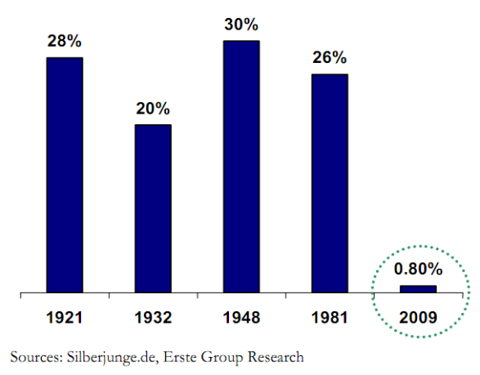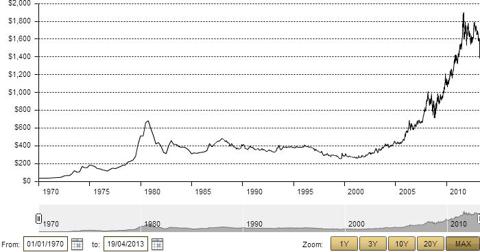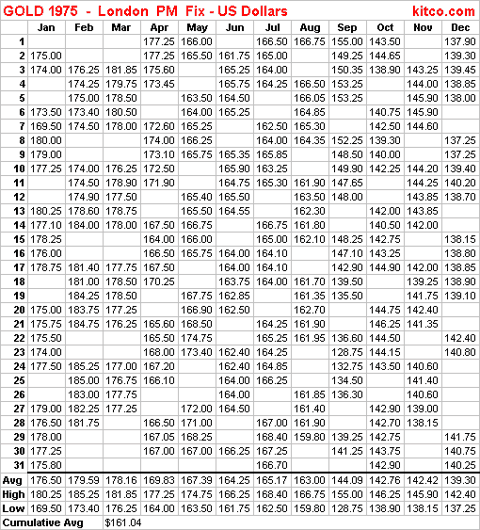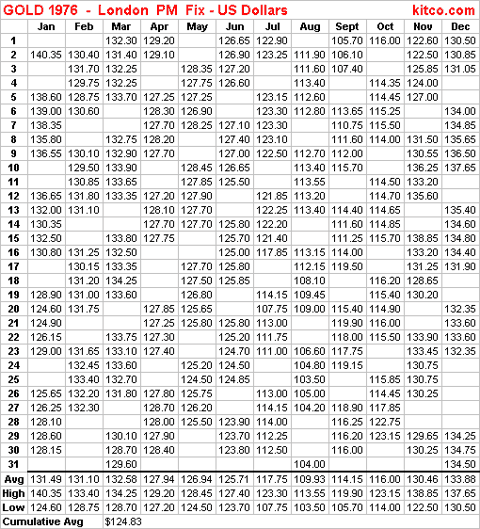10 Reasons Gold Will Shine Again
Apr 26 2013, 11:23
by: John A. Sarkett
.
It took a year but gold fell down to that $1,368 level and then some (futures low, April 16, $1,321.50) this month. Now that the shiny metal (GLD) has rebounded a bit, is $3,283 next, give or take?
We think that $3,283 is possible in the not too distant future, though we might have to traverse choppy waters (e.g. gold with a $1,000 handle) to get there. But after that, many think we could make new highs with numbers that will astound, say $8,500 (we do the math below).
Whatever the high print will be, we're convinced gold will make new highs down the road. Here are 10 reasons:
1. Central banks are buyers, not sellers, now. The World Gold Council reports that Central bank buying for the full year rose by 17% compared to 2011, totaling 534.6 tons, the highest level since 1964. Central bank purchases stood at 145.0tn in Q4, up 29% on the corresponding quarter in the previous year, making this the eighth consecutive quarter in which central banks have been net purchasers of gold.
To put this in perspective, in 2010, Governments worldwide bought 77 tons of gold. In 2011 it was 457 tons. The salient fact is the change from seller to buyer. Central Banks were net sellers of gold for decades until 2010.
2. Let's get physical, demand rising for the "real thing." Frank Holmes notes that many investors are shunning the gold ETF in favor of physical. "On one day alone, April 17, buyers scooped up a record 63,500 ounces from the U.S. Mint." That's two tons of gold, and more than they bought in the previous two months combined.
We've all seen similar reports from the Far East. The plummet in paper gold prices was met by large contingents of buyers of the physical asset. We are in a post-Cyprus world now, and a bird in the hand, or gold coin, sure beats a digital cipher, at least for many.
Website GoldSeek reports: The U.S. Mint is suspending sales of one-tenth ounce American Eagle gold coins as inventories are depleted and need to be replenished. Demand for one-tenth ounce gold coins is up 118% from a year earlier. Sales on all sizes of coins have increased two-fold compared to the same period in 2012.
At this writing, however, we personally checked to see if Apmex could handle a 100 ounce order of Krugerrands, seems they could, at $60 over spot. No shortage, today, Thursday, April 25, 2013. Stay tuned.
3. Gold has demonstrated repeatedly and over time its ability to rebound. Market pundit Bill Fleckenstein makes the case for gold with a bit of history: "The gold market itself has experienced similar declines in the past, which have predicted nothing. In 1976, gold dropped from a high of $198 to $105 an ounce, a decline of about 40%. Interestingly enough, the last three days of that decline saw the market drop about 12% (similar to the amount lost during trading on Friday and Monday).
However, that collapse was a giant head-fake. Within about a year gold was back to its previous high (that would be $1,900 in today's environment), and over the course of the next four years it traded up over eight-fold from those lows, even as our Federal Reserve (under Paul Volcker) was trying to do the right thing in the end. (And when it was pursuing the wrong policies, prior to Volcker's appointment, that was kid stuff compared with what the Fed and the rest of the world's central banks are doing today.)" Indeed.
4. Manipulation to alleviate physical drawdowns illustrates bedrock demand. Many writers have commented on the drawdown in physical gold for delivery at futures exchanges and opined that gold's meltdown was engineered to alleviate the pressure. This would make the gold smackdown, in the longer term, then, a bullish event, rather than bearish.
5. Risk aversion. The recent rise and fall of bitcoin illustrates the desire to find alternatives to fiat money. So, too, the chill cast on bank depositors post-Cyprus. Bitcoins can crash, and fiat can be confiscated, but possession, they say, is 9/10ths of the law. Many want their wealth in their possession, not in a bank or futures exchange. (Think MF Global, Peregrine.) Only gold has no counter-party risk. Only gold has the universality of acceptance, and the 5,000 year history to do the job. That "barbarous relic" is still money, even today. Today's bitcoin, designed by programmers first to pay for pizza, didn't exactly inspire confidence out of the gate. Even if successful, today's bitcoin could be tomorrow's Groupon (GRPN), inspiring a host of imitators, and fracturing and diluting what was once a rather novel and pristine intellectual franchise. Want to invest significant net worth in a new asset class that can lose half or more its value in one day? I didn't think so.
6. Currency wars. Japan is right now creating a brand new $1T in fiat yen to stimulate its moribund economy. Via QE3, the US is doing the same, the Fed creating and buying $85b of bonds per month.
So we have an unlimited supply of global paper running head-on into a limited supply of precious metals. Can this end well? Many think not.
Greg Hunter's USA Watchdog cites legendary investor Jim Rogers, who says: "We have never had every government debasing their currency at the same time. . . . This is the first time in recorded history where you have most of them doing it all together. These are perilous times . . . one way or another, this is going to end badly."
Of April's gold smackdown, Rogers says, "This is normal. This is not unusual. I welcome it. I expect gold to go much, much, much higher over the next decade, but it will not and cannot until it starts having normal corrections." How high will gold go? Rogers says, "If the U.S dollar becomes confetti, any number you want to make up. They're printing U.S. dollars fast enough to turn them into confetti. Who knows how high gold will go as long as we have a mad man running the central bank."
7. Sentiment molto bearish. When gold plunged from $1,000+ to $675 in 2008, the pundits said gold was finished, kaput, finito - it wasn't a store of value in a crisis, which was true at that moment in time. Presently, traders, newsletter writers, even major, major gold bulls who had once upon a time called for astronomical figures, are now saying gold is dead, and heading lower, maybe for three figures.
But funny how things change, and how fast they change. After the 2008 plunge, by September 2011, less than three years later, gold had nearly tripled to top $1,900. The drop to $675 wasn't a time to be crying, it was a time to be buying. At this time, gold might head lower again, yes. And then it might triple (or more) again, as it did in the past.
8. Graham-Dodd realized. You want value? Top miners like Goldcorp (GG) are selling at book value. It has been five long years for that situation to emerge again - the last time was in 2008. Cost of production, all in, is around that $1,000 target some pundits are eyeing. Barrick (ABX) said Wednesday, April 24, 2013, that put all-in sustaining costs are at $950-$1,050/oz. Other companies cite the same ballpark range. At $1,000 gold, it's no longer profitable for many miners to keep producing. They may keep going, but new projects will be shelved. Eventually, shortages will result, especially as physical demand continues to grow vis-à-vis ever greater fiat creation. Eventually low prices will be the cure for low prices. They'll go back up, and in a hurry, just like before.
9. Bond bubble monies go where? When bond prices decline, and they will, eventually, according to the likes of bond king Bill Gross, where will the assets go? Gold and gold mining shares represent something like 1% of world assets. There is a lot of headroom there, especially when considering that in the period 1920 to 1980 the figure was more like 26%.
Percentage of world assets in gold and gold mine shares:

.
10. Chart-wise, and history-wise, bull move could still be intact down to $1,000. Even a move to $1,000 gold would leave gold in a bull market. History shows how.
The 1975-76 period showed just such a severe haircut, from $185.25 to $103.50 - a 44% decline. Just five years later, gold surged 850% higher. Could this happen again? In five or ten or 20 years? $1,000 gold x 8.5 = $8,500?
But the precursor might be a 44% off sale on previously $1,900 gold, or a drop to $1,064. How they howled at $1,321, what would the wailing and gnashing of teeth be like at $1,064? And yet that number might represent ground zero at Cape Canaveral for what comes next.
Gold $8,500 would make our last year's essay target, $3,283, look modest indeed. But this would merely be a repeat of history, circa 1975-1976, and therefore, "nothing new under the sun."
So the 2013 update version of our 2012 question might be: What's Next For Spot Gold: $1,000 Or $8,500? Or maybe both?
The bearish view? The one that makes $1,000 a reality? In a word, deflation. Just like 2008, contracting GDP and declining markets puts everything up for sale to raise cash. Yes, Virginia, we know gold can go down - big time - in that scenario.
Besides outright and unstoppable deflation, there are some other ways to break gold's back, so to speak, including but not limited to: confiscation, resumption of central bank sales, sales from the likes of major holders like John Paulson. For some more, and offbeat ideas along this line, read this essay, "Five reasons gold will unfortunately be worthless after the collapse of the dollar." You may not agree, but it may provide some food for thought.
No investment is a sure thing.
We know one other important thing for sure: Gold is not for sissies. When they turn off the printing presses in Washington and Tokyo and points in between, when governments balance their budgets, when the G20 lives within its means, the fat lady will sing her aria, and the gold bull will be over. We're not there; we're not close. So we'll continue to have big moves up and down.
So far, the orchestra has perhaps finished the prelude, and so we all take a collective breath, but we still have three long acts and two intermissions to go. The fat lady? She has not yet left her dressing room. She wouldn't even yet be heard over the din of those printers next door. Those presses will have to be turned off during her performance. Then, and only then, "the fat lady sings." When will that be?
Source: World Gold Council

London gold prices, 1975-1976, source kitco.com



0 comments:
Publicar un comentario